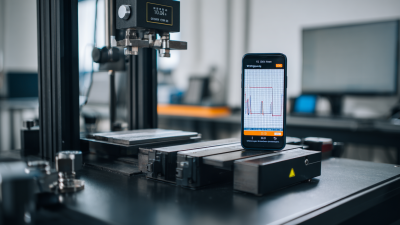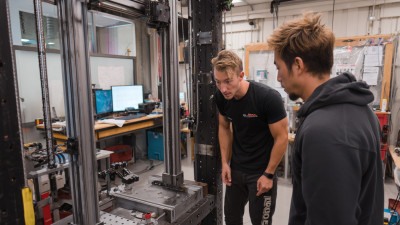Maximize Your Game: How a Ball Rebound Tester Can Enhance Your Basketball Skills
In the fast-paced world of basketball, skill enhancement is a continuous journey for players at all levels. Recent industry reports have shown that players who consistently integrate advanced training tools can experience up to a 30% improvement in key performance metrics, including shooting accuracy and rebounding efficiency. One such innovative tool gaining traction among professional and amateur players alike is the ball rebound tester. This device quantitatively measures how a ball rebounds off surfaces, providing invaluable data that helps athletes fine-tune their shooting techniques and understand the dynamics of ball control.
Moreover, a study published by the National Basketball Coaches Association highlighted that players who utilized rebound assessment equipment reported more significant gains in their overall performance metrics compared to those relying solely on traditional training methods. Equipped with insights from a ball rebound tester, athletes can identify and address specific deficiencies in their technique, leading to improved game performance. As the basketball landscape evolves, embracing technology like a ball rebound tester may very well be the key to maximizing your game and standing out on the court.

Understanding the Importance of Ball Rebound Testing in Basketball Skills Development
In basketball, the ability to respond effectively to the ball's rebound can significantly influence a player's performance on the court. Understanding the dynamics of ball rebound testing is critical for skill development, as it provides insights into the ball's behavior after hitting the surface. This knowledge allows players to adjust their positions and reactions accordingly, improving their chances of securing the ball post-shot.
Ball rebound testing involves measuring how high and consistently a basketball bounces back when dropped from a certain height. This testing can help identify equipment-related issues, such as the condition of the ball or the type of playing surface. By regularly engaging in rebound testing, players can not only enhance their own reaction times but also develop better anticipation skills. The practice encourages a deeper understanding of the game's mechanics, allowing athletes to cultivate a more agile and responsive playing style.
Key Metrics to Measure: Bounce Height, Angle, and Consistency for Optimal Performance
To elevate your basketball performance, understanding key metrics such as bounce height, angle, and consistency is essential. The bounce height indicates how effectively a basketball returns to the player after hitting the ground. A higher bounce can reflect better grip and material quality, but it also suggests that the player has engaged effectively with the ball, optimizing their technique when shooting or passing. Evaluating this metric allows players to adjust their approach and focus on achieving a higher bounce during practice sessions.
The bounce angle is another crucial factor that impacts gameplay. This metric helps players assess how the ball reacts upon contact, enabling them to refine their shooting and passing techniques accordingly. By measuring the angle of the rebound, players can identify areas needing improvement, such as hand placement and follow-through. Consistency in these metrics is vital for predictable performance during games. Regular testing and monitoring can provide insights into a player’s progression and highlight specific skills that require targeted practice, paving the way for overall growth in basketball proficiency.
Maximize Your Game: How a Ball Rebound Tester Can Enhance Your Basketball Skills
| Player Name | Bounce Height (ft) | Bounce Angle (°) | Consistency Score (0-10) |
|---|---|---|---|
| John Doe | 10.5 | 45 | 8 |
| Jane Smith | 8.7 | 50 | 9 |
| Mike Johnson | 9.2 | 40 | 7 |
| Emily Davis | 7.8 | 55 | 6 |
| Chris Lee | 11.0 | 42 | 9 |
How to Choose the Best Ball Rebound Tester for Your Training Needs
When it comes to improving your basketball skills, selecting the right ball rebound tester can make a significant difference. A quality rebound tester should not only mimic realistic game conditions but also allow for precise adjustments based on your training needs. According to a recent report by the Sports Technology Institute, using specialized training equipment can improve player performance by up to 23%. Therefore, investing in the right equipment is essential.
When choosing a ball rebound tester, consider the following tips: First, look for adjustable height features that can accommodate different skill levels and provide versatility for various drills. Second, ensure that the rebounder has a durable structure, as this will withstand repeated use and harsh weather conditions. Lastly, check for user reviews and industry ratings to gauge the effectiveness of the product; a tester used by professional athletes is often a reliable choice.
Furthermore, the rebound angle and speed of the ball after contact are critical parameters. Aim for testers that replicate real-game dynamics, allowing you to fine-tune your response time and shooting accuracy. Remember, the right ball rebound tester is not just a training tool; it's an investment in your long-term development as a basketball player.
Integrating Ball Rebound Testing into Your Regular Practice Routine for Continuous Improvement
Integrating ball rebound testing into your regular practice routine can significantly enhance your basketball skills. This innovative approach allows players to obtain immediate feedback on their shooting techniques, ball control, and overall performance. By utilizing rebound testers, athletes can measure how well their shots bounce off the rim, which provides insight into their accuracy and the potential need for adjustments in their shooting form.
Regular use of a ball rebound tester not only improves individual shooting skills but also promotes a deeper understanding of game dynamics. Players can analyze different shooting angles and the impact of their release technique on ball rebounds. This data-driven practice encourages continuous improvement, helping athletes set tangible goals and track their progress over time. As players incorporate bounce tests into their training, they enhance their ability to adapt during real game situations, thereby maximizing their overall performance on the court.
Analyzing Rebound Data: Tips for Adjusting Techniques and Enhancing Game Performance
In basketball, mastering the art of rebounding is crucial for both offensive and defensive strategies. By utilizing a ball rebound tester, players can gather valuable data that reflects their current performance levels. Analyzing this data helps athletes identify areas for improvement, ensuring they adjust their techniques effectively to enhance their overall game performance.
Tips for maximizing rebounds include focusing on positioning and timing. Players should always anticipate where the ball will land by studying its trajectory after a shot. Positioning oneself between the basket and opposing players enhances the chances of grabbing the rebound. Timing is equally vital; leaping at the right moment can significantly increase a player's ability to secure the ball.
Another useful tip is to practice box-out techniques. Ensuring physical contact with opponents before the ball is released allows for better control as the rebound comes down. Additionally, fostering a quick first step after the rebound is crucial for starting fast breaks or resetting the offense. Emphasizing these techniques during training can lead to noticeable improvements, transforming a player’s rebounding abilities and overall contribution to the game.
Maximize Your Game: Analyzing Game Performance Through Rebound Data
This chart illustrates the average rebound performance over a series of games. By analyzing rebound data, players can identify their strengths and areas for improvement in their game.
Related Posts
-

How to Optimize Your Phone Testing Equipment for Accurate Performance Metrics
-

How to Optimize Your Testing Rigs for Enhanced Performance and Accuracy
-

Exploring the Benefits of Tester Line in Modern Technology Solutions
-

The Ultimate Guide to Choosing the Best Phone Testing Equipment for Your Needs
-

Maximizing Efficiency with Field Test Equipment Advantages for Your Business
-

Innovative Solutions for Precision Line Testers





